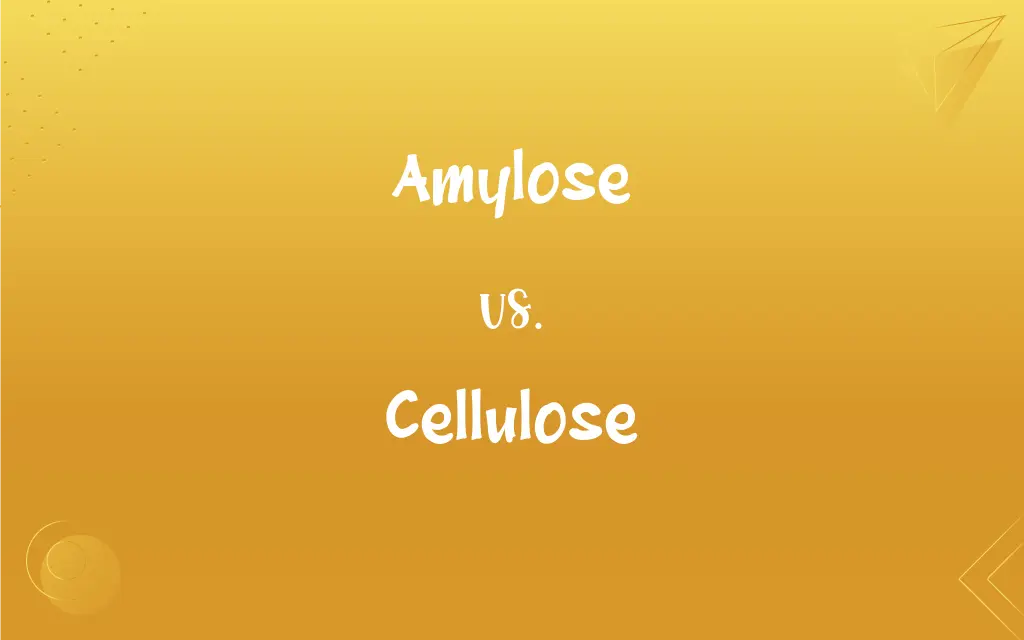Amylose vs. Cellulose: What's the Difference?
Edited by Janet White || By Harlon Moss || Published on November 6, 2023
Amylose is a linear polymer of glucose found in plants, mainly as a component of starch, while cellulose is a complex carbohydrate that forms the primary structural component of green plants.

Key Differences
Amylose and cellulose are both polysaccharides, which means they are large molecules made up of smaller sugar units. However, their structures, functions, and places in the natural world distinguish them significantly from one another. At their core, the primary difference lies in their molecular arrangement and purpose in plants.
Amylose is a component of starch, which is the stored energy of plants. It is primarily found in seeds and tubers where plants store energy for future use. Amylose is a straight chain molecule, comprised of glucose units connected by α-1,4-glycosidic bonds. This linear structure allows it to be more compact, making it perfect for storage purposes.
Cellulose, on the other hand, is a structural molecule in plants, providing rigidity to the cell walls of green plants, ensuring they can stand upright and resist external pressures. Unlike amylose, cellulose is a linear chain of glucose units too, but they are connected by β-1,4-glycosidic bonds. This configuration gives cellulose its strength and rigidity, making it essential for the plant's structural integrity.
The human digestive system responds differently to amylose and cellulose. While enzymes in our bodies can break down amylose into usable sugar, humans lack the necessary enzymes to digest cellulose. This is why we can obtain energy from consuming starch-rich foods but consider cellulose or dietary fiber as indigestible.
In the broader scope, both amylose and cellulose play pivotal roles in nature. Amylose provides energy reserves for plants, which in turn nourish animals and humans. Cellulose, being a primary component of plant cell walls, supports the growth and sustenance of immense forests and plant-based ecosystems, reinforcing the interconnectedness of life on Earth.
ADVERTISEMENT
Comparison Chart
Component of
Starch
Plant cell walls
Function in Plants
Energy storage
Structural support
Bond Type
α-1,4-glycosidic bonds
β-1,4-glycosidic bonds
Digestibility in Humans
Digestible
Indigestible (considered dietary fiber)
Molecular Structure
Linear glucose chain
Linear glucose chain with different bonding
ADVERTISEMENT
Amylose and Cellulose Definitions
Amylose
A straight chain molecule of glucose units.
The structure of amylose allows it to store energy efficiently in plants.
Cellulose
A linear chain of glucose with β-1,4-glycosidic bonds.
The bond configuration in cellulose provides strength to plant cell walls.
Amylose
A glucose polymer connected by α-1,4-glycosidic bonds.
The specific bond type in amylose differentiates it from other polysaccharides.
Cellulose
The primary structural component of green plants.
The presence of cellulose enables trees to stand tall.
Amylose
The energy storage molecule in plants.
Seeds and tubers store energy in the form of amylose for future growth.
Cellulose
A complex carbohydrate forming plant cell walls.
Cellulose gives plants their rigid structure.
Amylose
A polysaccharide and component of starch.
Potatoes have high amylose content, contributing to their starchy nature.
Cellulose
A polysaccharide utilized in various industries.
Cellulose is often processed to produce paper and textiles.
Amylose
A digestible component in the human diet.
Foods high in amylose provide energy when consumed.
Cellulose
An indigestible fiber in the human diet.
Consuming vegetables provides dietary cellulose that aids digestion.
Amylose
A linear, unbranched polysaccharide that is one of the two main components, along with amylopectin, of starches.
Cellulose
A polysaccharide, (C6H10O5)n, that is composed of glucose monomers and is the main constituent of the cell walls of plants. It is used in the manufacture of numerous products, including paper, textiles, pharmaceuticals, and insulation.
Amylose
(carbohydrate) The soluble form of starch (the insoluble form being amylopectin) that is a linear polymer of glucose.
Cellulose
A complex carbohydrate that forms the main constituent of the cell wall in most plants and is important in the manufacture of numerous products, such as paper, textiles, pharmaceuticals, and explosives.
Amylose
One of the starch group (C6H10O5)n of the carbohydrates; as, starch, arabin, dextrin, cellulose, etc.
FAQs
What role does cellulose play in plants?
Cellulose provides structural support, making up the cell walls of green plants.
Can humans digest amylose?
Yes, humans can digest amylose and obtain energy from it.
Is amylose a component of starch?
Yes, amylose is one of the two main components of starch.
Is cellulose considered a dietary fiber?
Yes, cellulose is an indigestible dietary fiber in the human diet.
How does the bond type in cellulose differ from amylose?
Cellulose has β-1,4-glycosidic bonds, different from amylose's α-1,4-glycosidic bonds.
What is amylose primarily used for in plants?
Amylose serves as an energy storage molecule in plants.
What bond type does amylose have?
Amylose has α-1,4-glycosidic bonds between glucose units.
Do both amylose and cellulose consist of glucose units?
Yes, both are polysaccharides made up of glucose units.
Can animals digest cellulose?
Some animals, like cows, have microbes in their guts that can break down cellulose.
Why is amylose important for plant survival?
Amylose stores energy that plants can use during periods of growth or when energy is scarce.
Is cellulose used in any industries?
Yes, cellulose is processed for use in industries like papermaking and textiles.
How does the digestibility of amylose affect our diet?
Foods rich in amylose provide energy when broken down and digested by humans.
What's the relation between cellulose and dietary fiber in foods?
Cellulose contributes to the dietary fiber content in foods, aiding in digestion and gut health.
Where can you commonly find amylose in plants?
Amylose is typically found in seeds, tubers, and other plant storage organs.
Why can't humans digest cellulose?
Humans lack the necessary enzymes to break down the β-1,4-glycosidic bonds in cellulose.
Can cellulose be chemically modified for other applications?
Yes, cellulose derivatives are used in pharmaceuticals, food products, and other applications.
Which molecule is linear: amylose or cellulose?
Both amylose and cellulose have linear structures, but their bond types differ.
Are there foods specifically high in amylose?
Yes, foods like potatoes and certain rice varieties are known for their high amylose content.
Do all plants contain cellulose?
All green plants have cellulose in their cell walls, giving them structure and rigidity.
What provides rigidity to plant cell walls?
Cellulose is the primary molecule that gives rigidity to plant cell walls.
About Author
Written by
Harlon MossHarlon is a seasoned quality moderator and accomplished content writer for Difference Wiki. An alumnus of the prestigious University of California, he earned his degree in Computer Science. Leveraging his academic background, Harlon brings a meticulous and informed perspective to his work, ensuring content accuracy and excellence.
Edited by
Janet WhiteJanet White has been an esteemed writer and blogger for Difference Wiki. Holding a Master's degree in Science and Medical Journalism from the prestigious Boston University, she has consistently demonstrated her expertise and passion for her field. When she's not immersed in her work, Janet relishes her time exercising, delving into a good book, and cherishing moments with friends and family.






































































